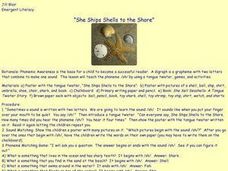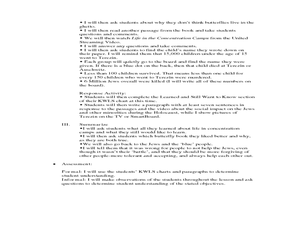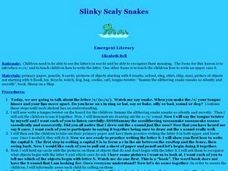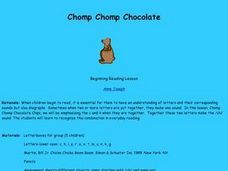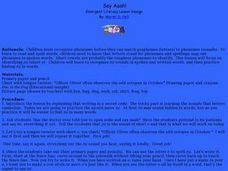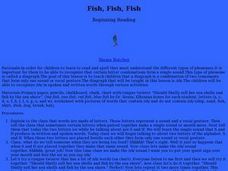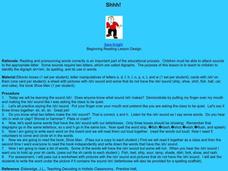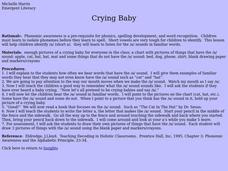Curated OER
The Laughing Leaf
Students demonstrate real-object writing. They discuss a leaf that has human attributes, and using a real leaf write a story about a leaf that tells them a joke, and create an illustration of themselves and their leaf.
Curated OER
Trade Along the Silk Road
Students do a jigsaw activity that will enable them to understand the dynamics of the Silk Road trade. They will break up into smaller groups to discuss an important section of an article. Large groups engage in an activity about the...
Curated OER
She Ships Shells to the Shore
First graders identify the digraph /sh/ in written and spoken language. After a brief discussion the independent and combined sounds of the phonemes /s/ and /h/ students practice identifying initial and final placement of the new digraph...
Curated OER
Article Review Grammar
In this articles worksheet, students read three short unrelated paragraphs that have all the articles missing. Students insert "a" or "an" or "the" in each blank. Note: There is the name of a professor at the top of the page.
Curated OER
Lesson on Wayne Thiebaud
Fourth graders view Theibaud's work in order to form opinions and share in class discussions. They also critique some of the artists work using the Linderman method and recreate the artist's style of work with their own paintings.
Curated OER
Heavy: The Story of Metal (Part 1) (Lesson 2)
Learners analyze the images of heavy metal bands. They view video clips of the band KISS and discuss. They design their own heavy metal band costume.
Curated OER
Political and Social Impact of World War II
Sixth graders study the life in Jewish ghettos during World War II and learn about tolerance and compassion. In this WWII activity, 6th graders discuss Jewish ghettos but with a mistreatment of the kids with stickers to signify the...
Curated OER
Agriculture Counts
Students discuss ways in which agriculture impacts their lives on a daily basis. In groups, they brainstorm ideas that they could possibly write about. They write a rough draft, participate in peer editing and write a final draft of a...
Curated OER
Line Breaks with Roethke
Fifth graders explore line breaks and write father poems. They write about something they have done with a family member.
Curated OER
Agriculture Counts
Learners focus upon the agricultural economy found in Oklahoma. Upon the completion of research they write an essay with the topic of "Agriculture Counts". The lesson includes an extensive introduction for teachers and students to create...
Curated OER
Imagery on Fabric
Students practice placing images on their completed quilts. Using their quilt they made in an earlier lesson, they print off photographs from a printer and use heat to transfer them to the fabric. They share their quilts with the class.
Curated OER
Slinky Scaly Snakes
Students examine the sound of the letter S and write the upper case S. As a class, they repeat a tongue twister with the letter S, then observe and demonstrate how to write the letter S. Students then view a variety of objects and...
Curated OER
Can You Slither Like a Snake?
Students explore letter-sound correspondences. They explore the letter s and the sound produced by the letter. Students explore how to write both the upper and lower case forms of the letter s. Students identify s in both written and...
Curated OER
Chomp Chomp Chocolate
Students identify the digraph /ch/ in written and spoken language. Students practice identifying the initial and final placement of the digraph /ch/ in words by identifying pictures containing the sound. They read a decodable story...
Curated OER
Say Aaah!
Pupils complete a variety of activities as they explore/review the letter 'o' as it makes the short /o/ sound. They recite short /o/ tongue twisters and practice writing the letter 'o'. They rewrite 'Skip to My Lou" using short /o/...
Curated OER
"Shhh," said the Fish
Students explore the /sh/ digraph and discover how it is pronounced. They practice writing the 'sh' digraph and recite an /sh/ tongue twister. They listen to Dr. Seuss' 'One Fish, Two Fish, Red Fish, Blue Fish' and write the /sh/ words...
Curated OER
"Shhh!" said Miss Trish
Young scholars explore the /sh/ digraph and how it is a blending of the /s/ and /h/ sounds. They listen to and then repeat /sh/ tongue twisters. They listen for and identify /sh/ words in 'One Fish, Two Fish, Red Fish, Blue Fish' by Dr....
Curated OER
Slithering Silly Snake
Students practice letter recognition for the /s/ sound in both lower and upper case formats. They listen as the book, "Saturday Night at the Dinosaur Stomp," by Carol Shields is read to them and then they complete a worksheet containing...
Curated OER
Fish, Fish, Fish
Students identify the digraph /sh/ in written and spoken language. After a brief discussion the independent and combined sounds of the phonemes /s/ and /h/ students practice identifying initial and final placement of the new digraph /sh/...
Curated OER
Chips - Beginning to Read
Students practice writing, sounding out, and spelling words with the /sh/ digraph. They listen as the teacher says words with the /sh/ digraph. They then use Elconin boxes and letter manipulatives to spell /sh/ digraph words. They make...
Curated OER
Shhh!
Young scholars practice identifying and spelling words containing the /sh/ digraph. They listen as the teacher says different words, and identify those with the /sh/. They then complete a worksheet with pictures and write the words...
Curated OER
Creating Space
Students use simple lines and shapes to draw objects, figures, or animals.They explore the process of printmaking and making multiples, use repetition of simple shapes to create complex images, and inquire about a contemporary artist's...
Curated OER
Fun with Fish!
Students observe the phoneme and digraph /sh/ in spoken words. They discover a meaningful representation and practicie finding /sh/ in words. They read and spell words (using a letterbox lesson) that contain the phoneme /sh/.
Curated OER
Crying Baby
Students explore phonemes. They discuss the short a sound. Students discuss the shape their mouths make when saying /a/. They read familiar words with the /a/. Students read "The Cat In The Hat." They identify words with the short a sound.


